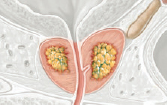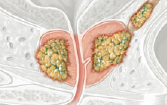Understanding Your Prostate Cancer
The prostate is a gland consisting of fibrous, muscular and glandular tissue surrounding the urethra below the bladder. Its function is to secrete prostatic fluid as a medium for semen, helping it to reach the female reproductive tract. Within the prostate, the urethra is joined by two ejaculatory ducts. During sexual activity, the prostate acts as a valve between the urinary and reproductive tracts. This enables semen to ejaculate without mixing with urine.
Prostate cancer, a malignant growth of cells in the prostate gland, is the most common cancer in U.S. men. Of all newly diagnosed cases of cancer in U.S. men, it is estimated that approximately 26% will be prostate cancer. Mortality rates due to prostate cancer have declined since 1991 because of earlier detection and better treatment. Although people with early or local prostate cancer may be experience symptoms, symptoms occur with disease progression, including painful urination and the presence of blood in urine. In people with advanced prostate cancer, the disease has often spread to the lymph nodes, lungs, and bones in the hip region.
Screening refers to testing to find a disease such as cancer in people who do not have symptoms of that disease. For some types of cancer, screening can help find cancers in an early stage when they are more easily cured. Prostate cancer can often be found early by testing the amount prostate-specific antigen (PSA) in the blood. Another way to find prostate cancer is the digital rectal exam (DRE).
If cancer is found, the tumor(s) will be graded on the aggressiveness of the disease, that is, how fast the cancer is expected to grow and spread. One system of grading is the Gleason Pathologic Scoring System. In the Gleason system, doctor uses a microsope to look at how cells from a biopsy at two different locations are arranged. The doctor assigns each group of cells and assigns them a score. Cells that look normal are given a low score, cells that look like cancer are given a higher score. The scores are added together to get a Gleason score of between 2 and 10. A lower score indicates a less aggressive cancer, and a higher score indicates a more aggressive cancer.

The cancer is not found during a digital rectal exam but found when doing a biopsy for increased prostate-specific antigen (PSA) or surgery for another reason. The cancer is located only in the prostate and is usually slow growing.

The cancer can be felt on digital rectal exam but has not yet spread outside the prostate. PSA levels are medium or low. There is an increasing risk that the tumor will grow and spread.

The cancer has spread outside the prostate but not to the lymph nodes. PSA levels are higher than Stage 2.

The cancer may have spread to nearby muscles, organs, lymph nodes, or other parts of the body.

